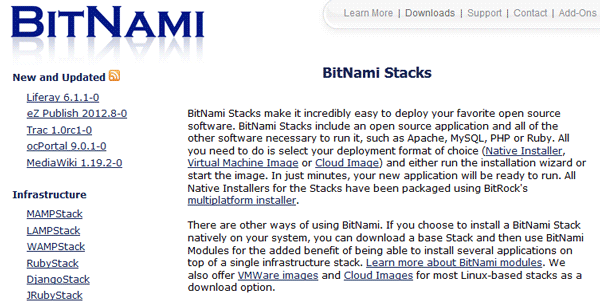- Bitnami Joomla Stack Free
- Bitnami
- Bitnami Joomla Stack Software
- Bitnami Magento Stack
- Bitnami Joomla Stack
- Bitnami Joomla Stack
Introduction
Apr 08, 2021 Customize your Moodle in three easy steps: 1. Js Stack Virtual Machines Bitnami Virtual Machines contain a minimal Linux operating system with Node. The full-stack MVC frameworks are bundled with scaffolding, template engines, websocket and persistence libraries to allow you build real-time scalable web apps. Bitnami provides a free all-in-one tool to install Drupal, Joomla!, WordPress and many other popular open source apps on top of XAMPP. Visit Bitnami XAMPP or click to see full list of add-ons for XAMPP. Launch this Stack Bitnami Joomla! Stack for Google Cloud Platform. Is an award winning open source CMS platform for building websites and applications. It includes page caching, page compression and Let’s Encrypt auto-configuration support. BitNami Joomla Stack. Download da youtube mac. The Bitnami Joomla! Stack provides a one-click install solution for Joomla. Includes all the critical features needed to manage Web content, including WYSIWYG editing, a file manager, navigation manager and template system. The Bitnami Joomla! Stack provides a one-click install solution for Joomla. Includes all the critical features needed to manage Web content, including WYSIWYG editing, a file manager, navigation manager and template system. It’s easy to build mobile websites and integrate RSS feeds.
Permission errors are usually associated with Linux and macOS installations. In these kinds of systems, files and directories have three operation privileges available: read (r), write (w) and execute (x). A system user can perform different operations depending on their operation privileges and the groups this user belongs to. For more information about permissions, see this guide. A permission issue occurs when an application (or system user) is performing an unauthorized operation in the filesystem.
Bitnami stacks are built with security in mind. They are configured establishing the most secure permissions without compromising the application user experience. In this sense, the standard way is the following:
Cloud Images and Virtual Machines:
- Have a system user for SSH/SFTP access: bitnami
- Have a system user and group for each daemonized process. These users will have extremely limited privileges. The reason for having multiple system users is to minimize the impact if a process' security is compromised. The following are the most common processes:
- Apache: daemon
- MySQL: mysql
- PostgreSQL: postgresql
- Tomcat: tomcat
The whole stack is only writable by root. By default, only read privileges are allowed for non-root users. As an exception, each daemonized process can only write to certain data folders and temporary folders. For example: mysql can write to /opt/bitnami/mysql/data and /opt/bitnami/mysql/tmp.
- If the bitnami system user wants to edit a file, it must obtain super-user privileges. To improve user-experience, the bitnami user can have ownership (with write privileges) of certain folders (for example, WordPress htdocs folder).
Installers with root installation: Same as the previous case but without the bitnami user. All operations must be done by root.
Installers with non-root installation and Windows installers: The user that executes the installer has full ownership of the stack and all its daemonized processes.
In this how-to guide you will learn how to deal with permission errors in your application. You will learn how Bitnami configures permissions in applications, what the common issues are, and some guidelines about how to fix issues in the stack.
How to detect
Detecting permission issues is quite straightforward. It usually implies an application crashing or showing errors (either in the logs or in the standard output) such as the following:
Or:
Bitnami Joomla Stack Free

Or:

These errors usually include the path that the process was unable to read of write.
Common issues
The following are the most common permission issues that Bitnami users face:
SFTP upload or file edit: Because of our secure permissions, a user cannot upload or edit files in all stack locations without super-user privileges.
The user modifies or changes the permissions: Either voluntarily or involuntarily, the user changes the stack’s default permissions. Because of this, the application stops working. A subset of this kind of cases is that of a manual upgrade issues.
Operation performed by the wrong system user: This mainly applies to the stacks that have command line utilities (such as Magento or ERPNext). If the user executes a command-line operation, an error may occur because the operation was executed by the wrong system user. Depending on this system user’s privileges, the stack can become unusable.
Plugin incompatibility: Some plugins require specific permissions for certain configuration files (for example wp-config.php in WordPress). These permissions can be incompatible with the ones Bitnami set by default.
Troubleshooting checklist
The following checklist covers the majority of cases described above. You can find and debug most permission issues.
Are you using the proper program to edit permissions?

FTP clients such as Filezilla cannot be used to modify the permissions in your stack. Instead, you should use a SSH client. To learn more about connecting through SSH, see this guide.
You can’t upload a file via SFTP?
If you see an error like this when uploading a file:
Temporarily change the permissions of the destination folder or file, upload the files, and then restore the file or folder to its original state. To do this, follow the steps below:
Log in to the server console. Learn how to connect to the server through SSH.
Execute the command in the target folder where you want to upload the file to (replace TARGETFOLDER with the proper path):
If you want to upload a file, replace the TARGETFOLDER placeholder with the full path to the file. The following is an example:
You will see an output like this:
Take a note of this information. In this case, the file or folder has the following permissions:
- Permissions: 0775
- Owner: daemon
- Group: daemon
Change the owner of the folder or file to bitnami (remember to replace the TARGETFOLDER placeholder with the proper path):
You should now be able to upload files to the folder or replace the file. When you are finished, restore the original permissions. For the case above, the commands are as follows:

You can’t edit a file via SSH?
If you are getting an error like this when trying to edit a file inside your SSH session:
Bitnami
You must edit the file with superuser privileges. Execute the command in the file you want to edit (replace TARGETFILE with the proper path). In this example we will use nano as the editor:
The saved file should maintain the original privileges.
Are the permissions in your stack set properly?

If your application crashes or shows an error like the following:
It is probable that the permissions in the stack are incorrect. These situations are normally due to a manual change in the permissions of the application.
Check the command history for permission change operations:
Check the output. Examples of this kind of operation are as follows:
If you do not find anything suspicious, create a ticket in Bitnami Support following the ticket creation guidelines.
Look at the original application configuration (you can launch a new fresh cloud instance of the application). Check the writable folders and check that the permissions are correct. The following is an example of Magento’s writable folders:
In this example we can see that the ownership is incorrect. daemon should be the owner of the files.
If the files' permissions are wrong, use the chmod or chown commands to restore them to their initial state. Following the example above, do the following:
If your stack uses MySQL, check and reset the permissions of the MySQL data directory:
If your stack uses MariaDB, check and reset the permissions of the MariaDB data directory:
If your stack uses Apache, reset the permissions of the Apache directory:
Check if the application works without issues now.
Are you getting an error when uploading a file, upgrading or installing an extension using the application interface?
The applications are configured with the most secure, production-enabled permissions. This set of permissions should not affect the normal operation of your application. If the user interface allows file uploading, plugin installation or upgrades, these procedures should work without issues. If you find an error during one of these processes, do the following:
Check that you did not modify any permissions in the stack.
If your permissions are ok, then create a ticket in Bitnami Support following the ticket creation guidelines.
Bitnami Joomla Stack Software
You can’t execute a command via SSH in the stack?
Bitnami Magento Stack
If you are trying to execute a command inside your stack and you get an error like this:
You may be executing the command as the wrong system user. To fix it, follow these instructions:
Load the application environment by executing the following command. Replace APPNAME with the name of your application:
The command should work now without any issues.
Bitnami Joomla Stack
Useful links
Bitnami Joomla Stack
The following resources may be of interest to you:
